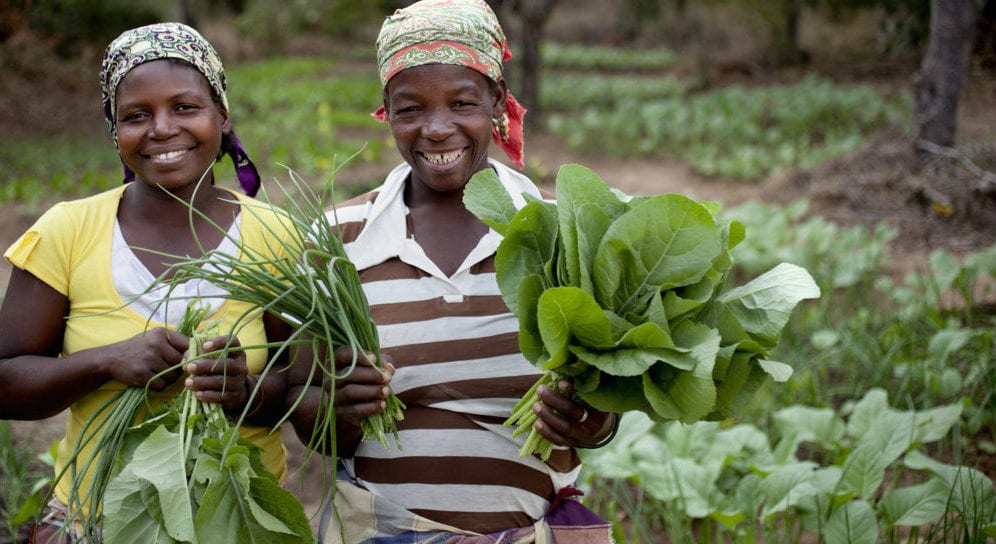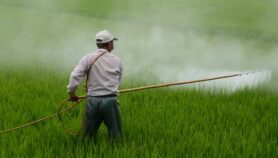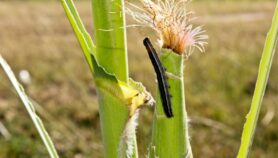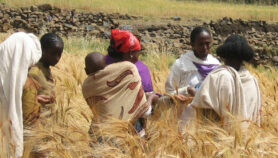By: Alberto Leny
Send to a friend
The details you provide on this page will not be used to send unsolicited email, and will not be sold to a 3rd party. See privacy policy.
Lydia Moraa sells African indigenous vegetables (AIVs) from makeshift stalls in the sprawling Toi market situated in Kibera, an expansive urban informal settlement in Kenya’s capital city, Nairobi.
Moraa tells SciDev.Net that although business is good, she and other women traditional vegetable sellers continue to face challenges. “Our main problem is the poor infrastructure at the market,” says Moraa. “When it rains, it is virtually impossible to access our stalls because the ground becomes so muddy and slippery that customers stay away. We wish the authorities would do something about the condition of the market, including the provision of water and sanitation facilities.”
2013 indigenous vegetable data for Kenya. Source: KALRO
Transporters from western Kenya, where most of the traditional vegetables come from, find it difficult to deliver the produce to the market during the rainy season and being highly perishable commodities, the traders also have to cope with storage and postharvest losses.
But agricultural researchers are now paying attention to these problems, although their findings are yet to make impacts both in the farms and markets.
Inadequate R&D for AIVs
Kenya’s Ministry of Agriculture will need to take a more aggressive approach through pro-active and effective extension services to ensure that such research outcomes benefit both the farmers and the traders, and in turn trickle down to consumers, Moraa says, when informed that researchers are taking a keen interest in AIVs.
When the rainy season is over, business is good at Toi market, Moraa adds, pointing at the heaps of different types of AIVs while attending to a group of customers, mostly slum dwellers from Kibera, whose population is estimated to be about one million.
Customers from the surrounding upmarket residential areas are also frequent visitors to the indigenous vegetable stalls. According to Moraa, prices vary according to the type and quantity of vegetables bought, adding that on average 100 Kenyan shillings (about US$1) is enough to feed a family of five for one day served with ugali (maize meal), Kenya’s staple food.
But despite the growing popularity of AIVs and their potential values for increasing nutrition, food security and income not much research has been conducted to address the issues involving their production, storage and marketing, says Lusike Wasilwa, assistant director of horticulture at Kenya Agriculture and Livestock Research Organisation (KALRO).
Emphasis on quality seeds
Wasilwa says supermarkets and grocery shops are also now selling indigenous vegetables, explaining that the former Kenya Agricultural Research Institute (KARI), now renamed KALRO, and several seed companies are now focusing on developing and selling quality indigenous vegetable seeds.
2012 data for top six indigenous vegetables in Kenya Source: KALRO
“These initiatives demonstrate that something [is being] done to move these crops from neglected, orphaned or underutilised vegetables by developing seed systems that although currently are weak, do exist in certain parts of the country,” says Wasilwa. “For a long time these vegetables were not discussed during priority setting exercises until 2006 and more recently in 2010, and this indeed did have an impact on the number of research activities”
Wasilwa adds that KALRO has changed the way it works by embracing agriculture product value chains to set its research agenda consultatively with stakeholders.
“Outputs from workshops so far held have placed indigenous vegetables in their own group and KALRO has undertaken priority setting using extensive criteria whereby amaranth, African nightshade, stinging nettle, pumpkin — Basella alba — and spider plant were the top six ranked indigenous vegetables,” says Wasilwa.
AIVs continue to play an important role in food security and nutritional balance in both rural and urban populations in Kenya and have been recognised as vital dietary components due to their perceived health promoting and protecting attributes, notes Jane Ambuko, a lecturer in the University of Nairobi’s department of plant science and crop protection and an expert on food security and nutrition.
A major challenge in the marketing and distribution of AIVs is their short shelf-lives, says Ambuko, , noting that like other leafy vegetables, they are made up of more than 90 per cent water and that even a slight decrease in moisture content of less than five per cent) renders them unsellable.
Water loss during storage and transportation results not only in wilting and consequent loss of aesthetic quality, but also leads to loss of saleable weight.
Water-soluble vitamins such as vitamin C are also lost as the vegetables wilt, explains Ambuko, who is a member of the High Level Panel of Experts on Food Security and Nutrition appointed by the Committee on Food Security of the FAO (Food and Agriculture Organisation).
Technologies and assessments needed
According to Ambuko, there is a need to use good postharvest practices and applicable postharvest technologies to ensure quality after harvest so that the consumers receive the highest quality while at the same time ensure good profits for smallholder farmers involved in AIVs production.
Ambuko adds: “While maintenance of cold chain from harvest to marketing of perishable products remains a major challenge in developing countries, simple postharvest technologies such as modified atmosphere packaging in suitable polythene have been proved to preserve quality and maintain the quality of perishable commodities.”
Such simple technologies should be explored for application in postharvest management and handling, Ambuko advises, saying that processing of AIVs during the high season into dehydrated or frozen products also offers an alternative strategy to reduce postharvest losses when production volumes are high.
“Processing diversifies product range and is an opportunity for smallholder farmers and traders to expand their market access. However, the processing of AIVs should be optimised to ensure that aesthetic and nutritional quality attributes are preserved,” says Ambuko.
Researchers feel indigenous vegetables should benefit rural women producers and traders such as those at Toi market, but the impact is still very low.
“The sad thing for Africa is that a lot has been done, but it is difficult to access the success stories or associated literature that supports development,” says Wasilwa.
Lack of evidence
Ambuko concurs with Wasilwa’s view, pointing out that there is hardly any documented literature on the impact of production and marketing of AIVs, and on incomes and livelihoods of rural folks in Kenya, while explaining that most of the studies on African indigenous vegetables are continuing so they cannot yet provide any papers authored.
The 2013 statistics on horticulture production by value in Kenya provided by KALRO shows the vegetable share as 48 per cent. When the vegetable components are divided, exotic vegetables account for 94 per cent, Asian vegetables one per cent and African indigenous vegetables five per cent.
“We know for a fact that in the last decade or so, many smallholder farmers have gone into commercial AIVs production. Those that supply urban areas such as Nairobi and environs are making good profits, but I do not have any real evidence of this,” Ambuko says.
|
No . |
Crop | 2010 | 2011 | 2012 | % Share 2010-2012 | ||||||
|
Area_ha |
Qty (MT) |
Value (Million Kenya Shillings) |
Area_ha |
Qty (MT) | Value (Million Kenya Shillings) |
Area_ha |
Qty (MT) |
Value (Million Kenya Shillings) |
|||
| 1 | Cow peas | 6,241 | 36,374 | 511.6 (US$5.6M) | 6,630 | 51,587 |
984 (US$10.8M) |
27,663 | 570,162 | 6,258 (US$68.5M) | 61% |
| 2 | African nightshade | 3,768 | 24,582 | 791 (US$8.7M) | 3,070 | 22,419 | 700.2 (US$7.7M) | 3,440 | 22,791 | 1,431 (US$15.7M) | 14% |
| 3 | Pumpkin fruit | 1,225 | 15,321 | 680 (US$7.4M) | 7% | ||||||
| 4 | Spider plant | 3,306 | 28,222 | 821.6 (US$9M) | 3,303 | 28,167 | 795.5 (US$8.7M) | 2,409 | 15,137 | 613 (US$6.8M) | 6% |
| 5 | Leaf Amaranth | 1,893 | 17,457 |
287.9 (US$3.2M) |
2,162 | 24,152 | 442.6 (US$4.8M) | 1,679 | 17,445 |
524 (US$5.7M) |
5% |
| 6 | Russian comfrey/ mafaki | 1 | 5 |
0.1 (US$0.001M) |
1 | 4 | 0.1 (US$0.001M) | 402 | 6,535 | 263 (US$2.9M) | 3% |
| 7 | Grain Amaranth | 0 | 0 | 0 | 0 | 0 | 0 | 682 | 3,068 | 202(US$2.2M) | 2% |
| 8 | Malaborgourd/ kahurura | 8 | 120 |
5.4 (US$0.06) |
37 | 150 |
9 (US$0.09M) |
276 | 5,209 | 165 (US$1.8M) | 2% |
| 9 | Pumpkin leaves | 431 | 3,305 | 76 (US$0.8M) | 494 | 14,124 |
363.4 (US$4M) |
597 | 2,561 | 82 (US$0.9M) | 1% |
| 10 | Jute mallow | 337 | 925 | 32.7 (US$0.4M) | 305 | 898 | 33.5 (US$0.37M) | 284 | 1,362 |
49 (US$0.5M) |
0% |
| 11 | Slender leaf/Rattle pod/ Mitoo | 504 | 2,814 | 119.2 (US$1.3M) | 446 | 2,481 | 95.1 (US$1M) | 308 | 1,099 |
45 (US$0.5M) |
0% |
| 12 | Vine Spinach | 64 | 531 | 12.1 (US$132,424) | 69 | 593 | 14.5 (US$0.2M) | 132 | 1,108 |
24 (US$0.3M) |
0% |
| Total | 17,200 |
120,87 8 |
2,714 (US$30M) | 17,390 | 149,944 | 3,500 (US$38.3M) | 39,097 | 661,798 | 10,337 (US$113M) | 100% | |
Performance of Leafy vegetables 2010-2012 in Kenya. Source: KALRO
This article has been produced by SciDev.Net's Sub-Saharan Africa desk.














